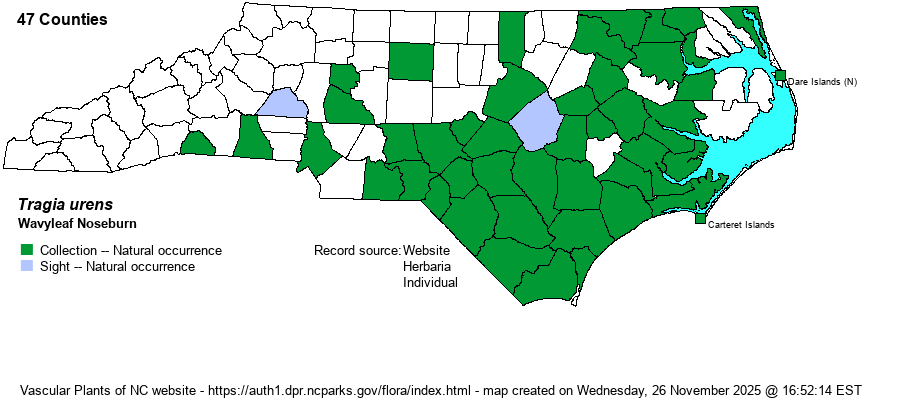| Author | L. | |
| Distribution | Coastal Plain and Sandhills, scattered in the southeastern and central Piedmont; also on the Outer Banks.
Mostly Coastal Plain, southeastern VA to southern FL and eastern TX; inland to low mountains in AL, GA. | |
| Abundance | Frequent to common in the Sandhills and the southern Coastal Plain, but mostly infrequent elsewhere in the Coastal Plain. Rare in the Piedmont portion of the range, mainly close to the Fall Line. Populations are typically small, usually as scattered individuals. | |
| Habitat | Xeric to dry Longleaf Pine-Wiregrass uplands, sandhills, dry savannas, oak-hickory woodlands and edges, openings in dry woods. |
| Phenology | Flowering and fruiting May-October. | |
| Identification | Wavyleaf Noseburn is a small and relatively inconspicuous plant mostly less than a foot tall, with a few to several ascending branches and rather few lance-shaped to broadly linear leaves. Leaves are sharp-pointed, short-tapered to the base, irregularly toothed or not, wavy margined or not; they tend to look leathery and dark, shiny green above. The whole plant has very short, translucent, stinging hairs. Nettleleaf Noseburn (T. urticifolia) has leaves with broad (often truncate) bases and abundant marginal teeth; it is mainly found in the Piedmont. Though present in many or most sizable tracts of suitable sandhills habitat, Wavyleaf Noseburn is usually stumbled on as a few scattered plants, with very inconspicuous flowers, hardly attracting much attention other than by the "do not touch" look with its stinging hairs (which a layperson will not realize until they grab the plant). | |
| Taxonomic Comments | None
| |
| Other Common Name(s) | Sandhills Noseburn, Southeastern Noseburn | |
| State Rank | S4 [S4S5] | |
| Global Rank | G5 | |
| State Status | | |
| US Status | | |
| USACE-agcp | | |
| USACE-emp | | |

